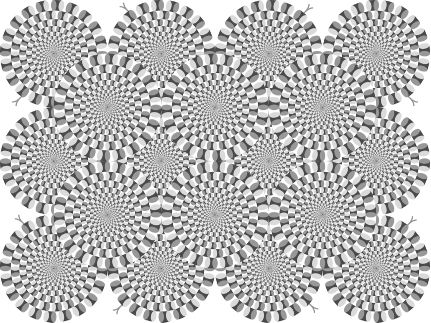Hack #30. Understand the Rotating Snakes Illusion
Shading in pictures combined with the continuous random jiggling our eyes make can generate compelling movement illusions.
We’ve all seen optical illusions in which parts of a completely static picture appear to drift and swirl. One of the most famous examples is Professor Akiyoshi Kitaoka’s rotating snake illusion (Figure 2-25), commonly passed around via email, but, sadly, rarely with explanation.

Figure 2-25. The rotating snake illusion, Akiyoshi Kitaoka © 2003, is available in color at http://www.ritsumei.ac.jp/~akitaoka/index-e.html
This is really a story about why you don’t see everything moving all the time rather than about why you see movement sometimes when it isn’t there. Your eyes constantly move in your head [[Hack #15]], your head moves on your body, and your body moves about space. Your brain has to work hard to disentangle those movements in incoming visual information that are due to your movement and those due to real movement in the world.
Another source of confusion for our visual system is a constant random drift in the exact focus of our eyes. 1 This happens between saccades (see Figure 2-5, for example, in [Hack #15]). Our muscles are constantly sending little corrective signals to keep our eyes in the same place. These signals never keep the eyes exactly still, producing so-called fixational movements. This is ...
Get Mind Hacks now with the O’Reilly learning platform.
O’Reilly members experience books, live events, courses curated by job role, and more from O’Reilly and nearly 200 top publishers.

